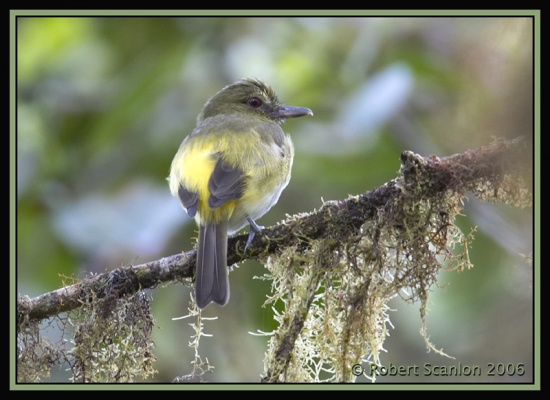- Attila spadiceus
Identification
17–21·5 cm
- Olive green, black streaked head
- Chestnut or olive back
- Bright yellow rump
- Brown wings and tail
- Two pale wing bars
- Dark streaked whitish-yellow throat and breast

Photo by Stanley Jones
Bosque del Río Tigre Lodge, Osa Peninsula, Puntarenas Province, Costa Rica, February 2015
- White belly
- Red iris
- Hooked, slightly upturned bill
Sexes similar
Juvenile: cinnamon-fringed crown and brown iris
Distribution
Central and South America
Central America: Mexico, Guatemala, Belize, El Salvador, Honduras, Nicaragua, Costa Rica, Panama, Trinidad
South America: Colombia, Venezuela, Guyana, Suriname, French Guiana, Ecuador, Peru, Bolivia, Brazil
Taxonomy
Subspecies
There are 12 subspecies[1]:
- A. s. pacificus: Coastal north-western Mexico (extreme southern Sonora to western Oaxaca)
- A. s. cozumelae: Cozumel Island (off Yucatán Peninsula of eastern Mexico)
- A. s. gaumeri: Tropical northern Yucatán Peninsula; winters to Holbox and Meco Islands and Isla Mujeres
- A. s. flammulatus: Tropical south-eastern Mexico (Veracruz) to El Salvador
- A. s. salvadorensis: Tropical El Salvador to north-western Nicaragua
- A. s. citreopyga: Tropical south-eastern Honduras and Nicaragua to western Panama
- A. s. sclateri: Tropical eastern Panama and north-western Colombia (upper Sinú Valley)
- A. s. caniceps: Tropical northern Colombia (middle Magdalena and lower Sinú valleys)
- A. s. parvirostris: Santa Marta Mountains (north-eastern Colombia) and north-western Venezuela
- A. s. parambae: Western Colombia (Río Atrato to Nariño) and north-western Ecuador
- A. s. spadiceus: Eastern Colombia to the Guianas, north-eastern Peru, northern Bolivia, northern Brazil; winters to Trinidad
- A. s. uropygiatus: South-eastern Brazil (Alagoas and Bahia to Rio de Janeiro)
Habitat
Secondary rain forest edges, humid lowland forest, pasture, plantations and shady gardens from 130 m to 2,100m.
Behaviour
Diet
The diet includes insects, spiders, frogs and lizards.
Breeding
They build a deep cup nest from mosses, leaves and plant fibre. The clutch consists of 2 dull white or pink eggs with lilac or rufous markings; these are inncubated by the female for 14-15 days. The young fledge 17 days later.
References
- Clements, J. F., T. S. Schulenberg, M. J. Iliff, D. Roberson, T. A. Fredericks, B. L. Sullivan, and C. L. Wood. 2014. The eBird/Clements checklist of birds of the world: Version 6.9., with updates to August 2014. Downloaded from http://www.birds.cornell.edu/clementschecklist/download/
- Avibase
- Wikipedia
- Handbook of the Birds of the World Alive (retrieved June 2015
Recommended Citation
- BirdForum Opus contributors. (2025) Bright-rumped Attila. In: BirdForum, the forum for wild birds and birding. Retrieved 16 May 2025 from https://www.birdforum.net/opus/Bright-rumped_Attila
External Links
GSearch checked for 2020 platform.1




